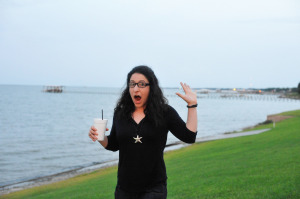by Sam Tackeff | Dec 18, 2013 | Blogging, Books, Gifts, omnivore books
This review was originally published over at Medium – a new-ish publishing platform that I’ve been playing with for the past few weeks. Medium has a clean, streamlined user interface which is quite conducive to both reading, writing and editing. This was my first post on Medium, but I couldn’t help cross posting here as well – it’s too important of a topic for me to leave off of the second lunch.
Melt: The Art of Macaroni and Cheese
When friends create something great — there is the perfect Yiddish word to describe it: naches.
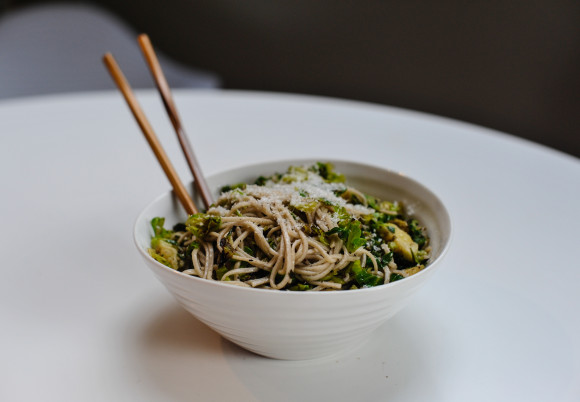
Five years ago, working at Omnivore Books, I started collecting cookbooks in earnest. I do my best to acquire a wide variety of subjects for my collection to learn as much as possible, and while doing so I am picky. I do my research. I avoid superfluous acquisitions. At this point, due to constraints in space and time, every new cookbook needs to matter. At Omnivore, I was in the right place at the right time — surrounded by people who cared about food as much as I did, and my desire for cookbooks became as voracious as my appetite. (It didn’t hurt that I could acquire books at cost — thank you Celia — and received many a review copy). My favorite cookbooks are the ones that tell great stories, are personal, and are unique to a time and a place.
After years of reading brilliant works: Nigel Slater, Paula Wolfert, Melissa Clark, Suzanne Goin, and Patience Grey to name a few, I started getting the itch. I wanted to write my own cookbook. I wanted to contribute to the literary canon. To write a cookbook you need a topic, an outline, and a collection of recipes. To write a great cookbook, you need a purpose, a sense of wonder, passion, and adventure, work ethic, and commitment to creating something truly marvelous. You need community — the people around you are just as much a part of the story. Anyone can write a cookbook, but to write a great cookbook takes so much more. For me, the task seemed daunting. After fretting about the magnitude of taking on a cookbook, I decided to repress my urges.
Over the past year, several of my acquaintances and friends have had proposals accepted, their first cookbooks published, and have even made the New York Times and Amazon bestseller lists. The flickering desires may be returning.
———
I met Stephanie Stiavetti in 2009, soon after I moved to the West Coast — I remember it vividly: I was invited to wine dinner at a swank San Francisco restaurant where I knew no one, and immediately felt awkward walking through the door. Wide-eyed and a little panicked, I stepped out into the hallway to breathe and there was this tiny force who saved me from loneliness. Her blog was called Wasabimon (now The Culinary Life), and I knew immediately that I’d like her. We passionately discussed food, technology, family, and then somehow this new acquaintance in an instant became a dear friend. It wasn’t until after I left San Francisco that I started reading Garrett’s blog — this too I remember clearly, because I read a single weekly post and proceeded to start right from the beginning and read the blog for hours over the course of a weekend like a novel. (Incidentally, I love doing this, but I feel like most bloggers would cringe at the thought of someone reading a post of theirs from five years back.)
When Stephanie and Garrett sold their proposal, I was thrilled! And, yet, I’ll be quite honest here: when I heard that it was going to be about macaroni and cheese, I was skeptical. There’s a fine line with monographs — single subject cookbooks have a tendency to be flash in the pan, trendy topics that end up remaindered. The lucky ones though, rise as the true authority on the topic, and these are the ones that I spend a good amount of time trying to collect. [Spoiler alert: Melt is the latter].
Melt isn’t really a book about macaroni and cheese. It’s a book about cheese, about discovery, and pushing boundaries in the kitchen. It’s a book for people who truly love food, who will seek out new flavors, and take risks. The recipes, while many of them are quite simple to make, are new, innovative, and may even seem a little bizarre. Risk in a cookbook is hard — as a home cook with a new book in hand you have to place a good deal of trust in the author. And with these two, I do.
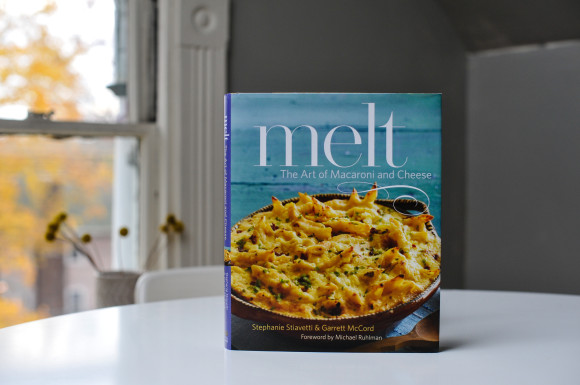
At the core of this book is cheese. And it comes at a good time — cheese lovers these days have much to get excited about. In Boston, we are truly lucky to have Formaggio Kitchen in the neighborhood, where Ishan Gurdal and his family have been building something very special these past twenty years. Formaggio is one of my second homes; their cheese cave rivals none.
For those not lucky enough to live by big city shops, no longer does one have to suffer with supermarket brick cheese as the primary option — many of the great cheesemongers including Formaggio, Murray’s, and Zingerman’s will ship. (I’d be remiss not to mention that Kirsten Jackson, who helped develop many of the pairings in this cookbook book has just started her own cheese of the month club.)
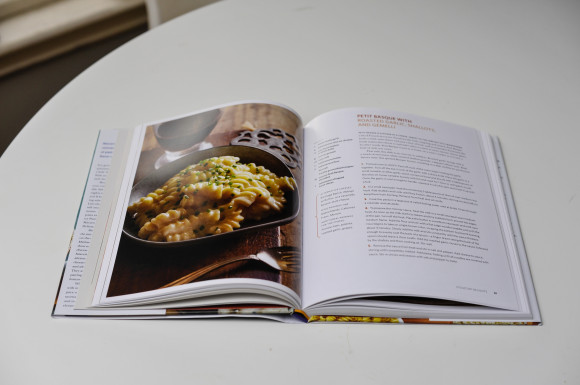
Photos shot and styled by the talented Matt Armendariz /Adam Pearson— make every recipe stand out
The truth is, I don’t usually write much about cookbooks because reviews make me nervous. To do a book justice, you have to write critically — and writing critically of people you hero-worship is a challenge. But here I’ll try to do my best, to share a taste of the cookbook, and the recipes within.
Melt is divided into five main chapters — the first one is 25 pages about the basics — how cheese is made, types of cheese, sourcing cheese, cooking with cheese, pasta, and cooking methods. The second chapter is completely devoted to salads with cheese and pasta. The third ‘Stovetop Delights’ has many of the more classic recipes you’d think of as macaroni and cheese. There are hearty recipes, and a chapter of desserts.
Each recipe has suggestions for alternative cheeses, wine pairings, and additional pairings for the cheese. The breadth of information in this book is quite impressive, but to give a better picture, I cooked through several recipes.
———
After reading through Melt from cover to cover, the first recipe that I tried was one of Garrett’s (the two split headnote writing duties) — soba noodles with parmesan and pan-seared brussels sprouts (pictured up top), one of those dishes that I almost always have the ingredients for: soba, oil, brussels sprouts, salt, pepper, chili flakes, garlic, and cheese. I loved the recipe because it was simple — and lately simple has been all that I’ve had time to make.
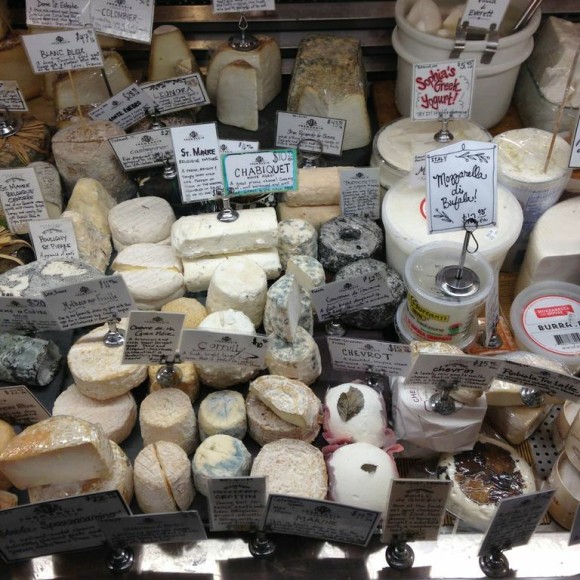
The case at Formaggio Kitchen
After the first attempt was a success — I wanted to push the boundaries a little bit, explore new cheeses I hadn’t tried. There are flavor combinations in Melt that are unlike anything I’ve ever tasted, and so many of them looked enticing. Would it be the chocolate pasta with Bucherondin, hazelnuts, and cherries? Or the Rogue River Blue with crab sauce over fettucine which looked awfully good, as did the Beecher’s Flagship Cheddar, with avocado, lime, and shell pasta. And then there was the Roquefort macaroni with beets, shallots, and poppy seeds. Or maybe thepaneer korma with idiyappam noodles. And then there were the smoked Idiazabal mason-jar potpies with lamb and tomato sauce. These were so cute, I couldn’t stand it.
I finally landed on a dish that was too exciting to pass up: the chicken breast stuffed with Leonora goat cheese, star pasta, and crushed gingersnaps. Leonora was a new-to-me cheese, a citrus-y goat cheese from the Léon region of Spain. The headnote, Stephanie’s this time, was alluring — magical.
The only tweak I made was to use chicken thighs instead of breasts, because, well, I think that white meat chicken is a waste of time, and the thighs are so much more robust. Heh.
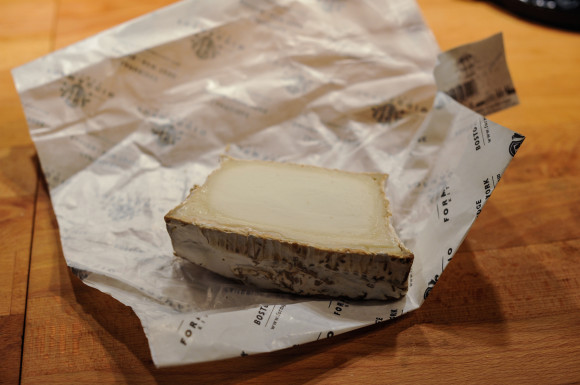
Leonora cheese
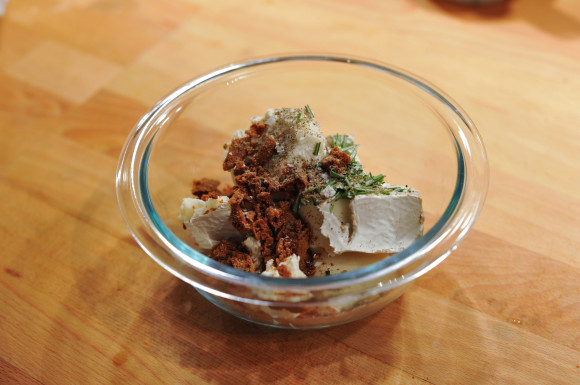
Leonora, Rosemary and Gingersnaps
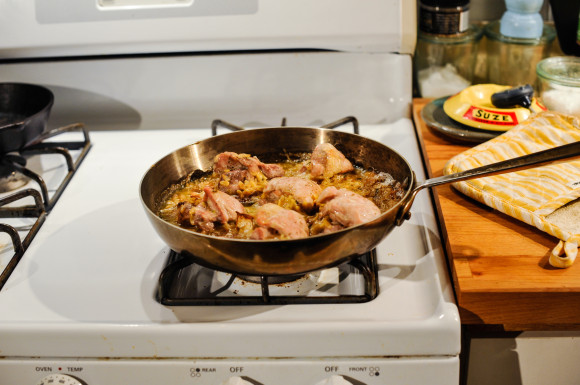
Chicken stuffed with Leonora cheese, rosemary, orzo, and gingersnaps.
I admit that while making this recipe, I was nervous— sure everything smelled delicious, but could I convince my better half that a dish that included a good amount of pungent goat cheese rind (you keep it in), and crushed cookies would actually be edible? Knowing that perception is half the battle, I decided to bite my tongue and just serve our meal. We tucked in, the bowls were finished, and the only critique being that the meal was a tad rich. (In my excitement, I had neglected to cook any vegetables.) Score #2 for my testing.
Another evening, the weather was cold, and I decided to try the tomato soup with star pasta and Vella dry jack crisps. I couldn’t find Vella Jack anywhere, so I ended up making the crisps with parmesan, one of the suggested alternatives. Normally when I want tomato soup, I take a jar of Rao’s tomato sauce, and thin it down with a little water. It does the trick, but comes at a steep cost, as Rao’s is priced high enough to put one into debt, quickly. This recipe was easy to make, getting depth of flavor from roasting canned tomatoes in the oven before starting the soup.
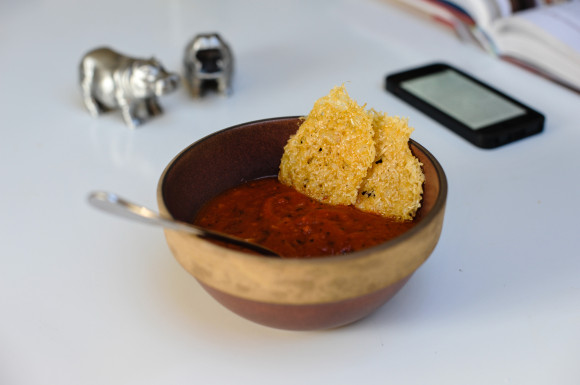
The cheese crisps too are remarkably easy: preheat the oven to 350 degrees, line a baking tray with parchment or a silicon mat, and bake little mounds of shredded cheese for 13-15 minutes until they crisp up. (I only had foil, and this still worked brilliantly.)
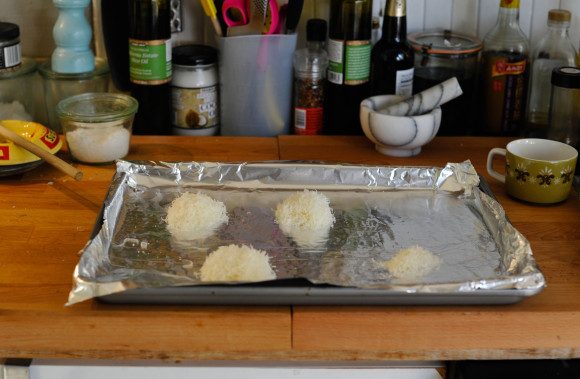
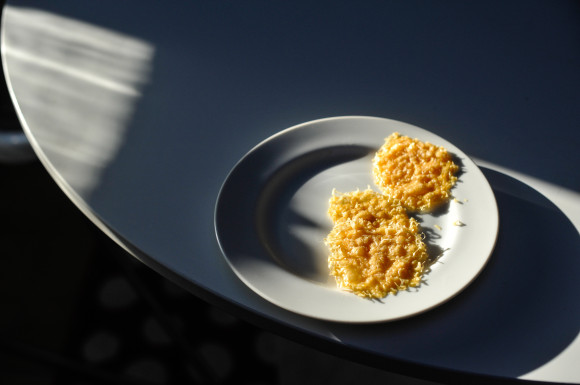
After three successes, and so many more recipes that I’d like to try, I’m able to say confidently that this book is well worth the purchase. It’d make a nice addition to the piles of cookbooks you’ll be giving underneath the Christmas tree. Or maybe consider it for a late Hanukkah gift. Or New Years. Or screw gift giving, and buy it for yourself.
What I’m even more excited about is that this is the very beginning — I’m already looking forward to the next volumes of Stephanie and Garrett that will grace my shelves.
Melt: The Art of Macaroni and Cheese
by Stephanie Stiavetti and Garrett McCord
Published by Little, Brown and Company
224 pages
by Sam Tackeff | Dec 14, 2011 | Books, Gifts
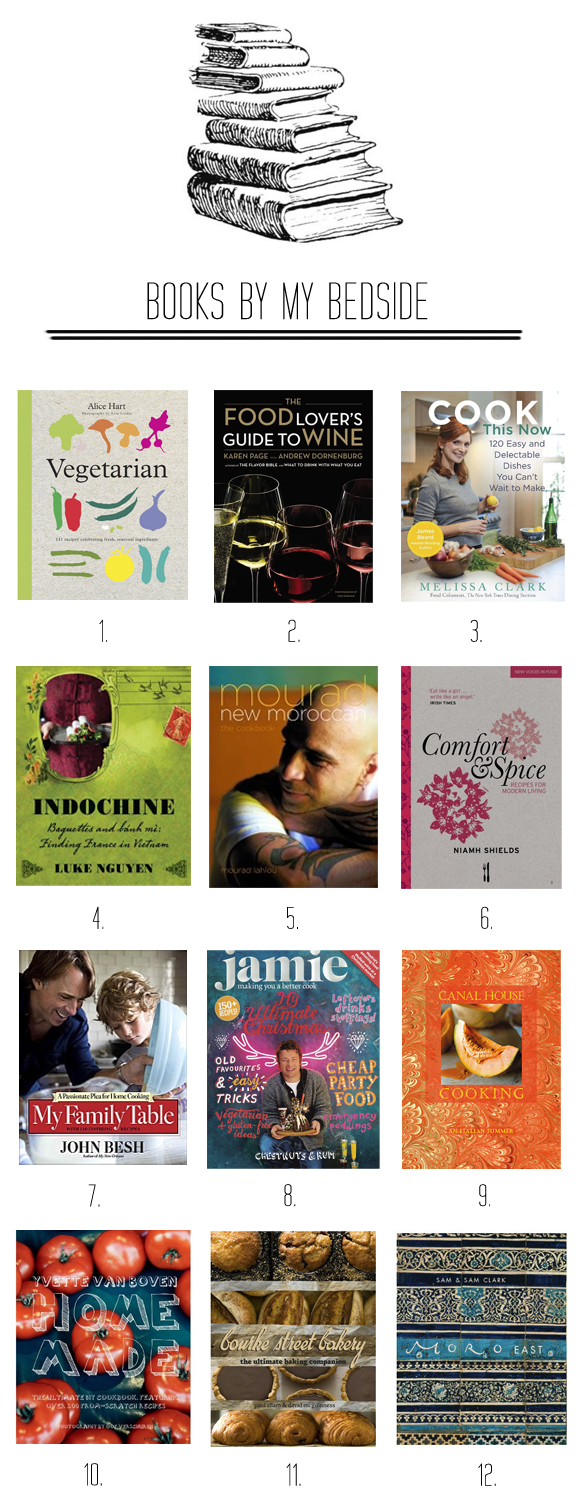
I read a lot of cookbooks (unsurprisingly). This is a small selection from the books stacked next to my bed right now*, and I’m still missing quite a few of my favorites. This was a very good year for cookbooks. I’m absolutely adoring all of these, and any one of them would make a fabulous holiday gift.
Image of stacked books from here. 1. Vegetarian by Alice Hart ; 2. The Food Lover’s Guide to Wine by Karen Page and Andrew Dornenburg ; 3. Cook This Now by Melissa Clark ; 4. Indochine by Luke Nguyen ; 5. Mourad – New Moroccan by Mourad Lahlou ; 6. Comfort & Spice by Niamh Shields ; 7. My Family Table by John Besh ; 8. Jamie Oliver Magazine, Christmas 2011 Issue ; 9. Canal House Cooking – Italian Summer ; 10. Home Made by Yvette Van Boven ; 11. Bourke Street Bakery by Paul Allam and David McGuinness ; 12. Moro East by Sam & Sam Clark.
What are your favorites right now?
* In fact, there are so many books next to my bed that they could form a small table, which, come to think of it, would be quite useful because I still don’t have very much furniture.
by Sam Tackeff | Dec 13, 2011 | Gifts, Local stores, Shopping, Tea
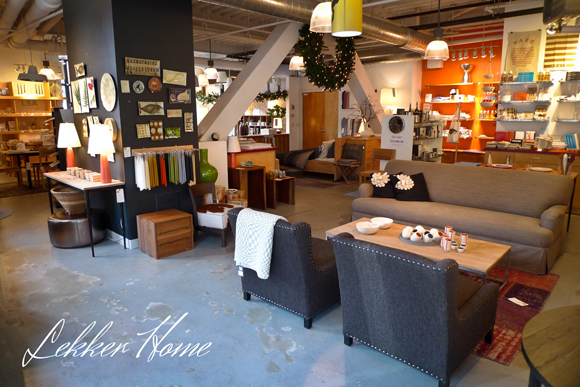
I’ve been having a lot of fun “re-discovering” the South End neighborhood of Boston. It’s definitely the up and coming place to live, shop and eat in the Boston area.
The South End has gone through massive changes over the past several decades, and I remember when it was a different place entirely. In the 80’s and early 90’s, my aunt and uncle lived in the South End in a gorgeous bow-front (with my two very young cousins), and ended up moving out when someone got stabbed to death on my aunt’s car.
But the neighborhood has fought back, and people have come together. Small businesses have been the life blood of this community, and a lot of people took big risks that have been paying off. In food, Hammersley’s has been going strong for over 20 years now, Barbara Lynch has three outposts – B&G Oysters, The Butcher Shop, and Stir; Joanne Chang’s Flour Bakery + Café flagship is here, as is Ken Oringer and Jamie Bisonnette’s Toro (and Coppa, which I’m desperate to try).
In addition to eating, the South End is also the place to shop. Firstly, SoWa Open Market is Boston’s portal to Brooklyn and the Mission: a vibrant market, part farmers’ market, part craftsman market, part flea market. Then there is Hudson – not the jeans– where I might shop I had unlimited funds. They have an outpost in Wellesley where I used to go and covet things in college. And then, among the treasures of the South End is Lekker Unique Home Furnishings.
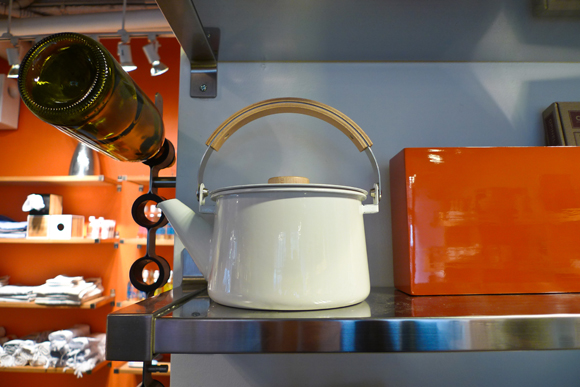
Lekker is one of those places that has the perfect gift for almost anyone. The store was opened by Natalie van Dijk Carpenter, a Dutch woman with incredibly good taste (lekker!) and curation skills.
The good thing about Lekker is that you can shop on a budget for yourself, or say for a hostess gift, and find some really excellent things. The store is filled with useful and stylish kitchen tools, candles, and local cookbooks. They also have some really graceful flatware and cutlery that I’d like to acquire. Or, if you are lucky enough to have generous resources, you can also find some fantastic furniture here.
I was particularly enthusiastic about that grey Jackson Chair, but it may in fact have been the most expensive item in the store at $3,650, alas.

This time, I got to go into Lekker with a hundred dollar credit from local Boston-based mobile payment service LevelUp. LevelUp allows you to pay with a unique QR code that is assigned to you – by whipping out your phone, opening the LevelUp app, and getting your code scanned at participating locations.
The big strength of LevelUp is that they work with community businesses to offer small credits at each location, and reward repeat shopping by offering better credits the more you frequent a particular establishment. The user interface is clean, and the process is simple. You store your credit card information securely, and can pay a tip with the app as well. In Boston, the majority of the merchants participating are restaurants, but it seems like a no-brainer to expand to all types of local businesses, particularly because of LevelUp’s low transaction fees.
I’ll be interested in how they scale in the longterm, and how they will compete with Google Wallet , Square, and whoever decides to throw themselves into the mobile payment space next.
I strongly believe that mobile payments and digital receipts are the way of the future, and am looking forward to the day when I can dispense of plastic credit cards and paper receipts completely.
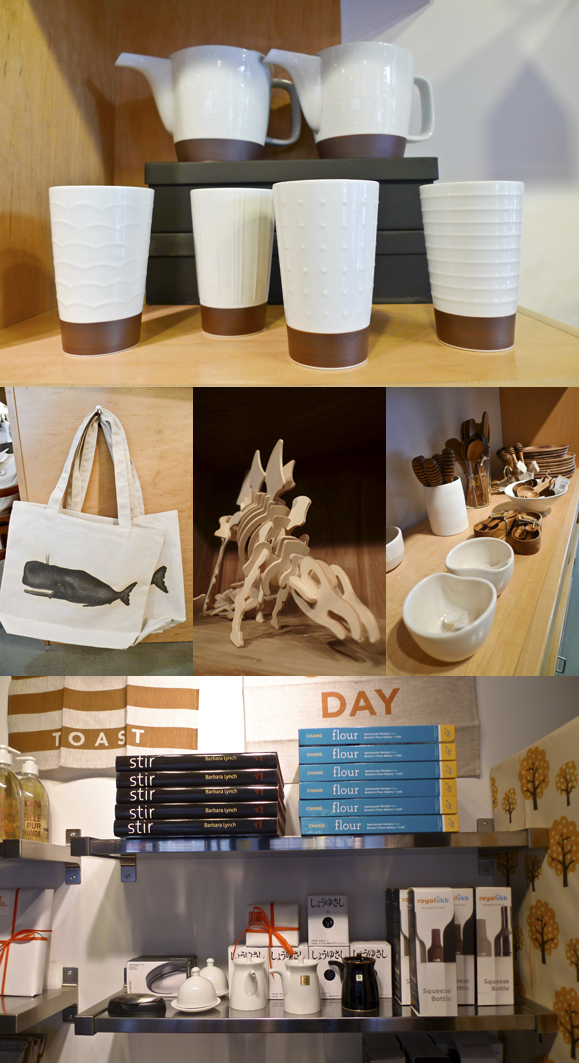
After an hour of browsing – dreaming, touching the curved lips of the bowls and mugs, stroking the softest blankets, and sitting on each of the chairs in the shop – I ended up picking up the Hakusan Tea Pot and set of cups (the white and brown one above, with the stippling on the porcelain). It’s a nice addition to my home, and great incentive to make myself happy with my tea project.
Lekker Home
1317 Washington Street Boston, MA 02118-2139
(617) 542-6464
by Sam Tackeff | Sep 14, 2010 | Gifts, Liquor, Mixed Drinks, Shopping

Scotch is classy.
Scotch is a man’s drink.
Scotch is, in fact, such a classy man’s drink that George Clooney is selling it to the Koreans.
I am neither a man, nor very classy (well, I do try sometimes). But, I love my liquor, and I feel a special kinship with Scotch Whisky that’s been years in the making.
My relationship with Scotch began, of all places, in a lab. A college geology lab, after dark, to be specific. In class we were learning about peat bogs, and someone decided to toast the 9,000 year old perfectly preserved peat bog man with some extra "peat-y" Scotch in his honor. And we may or may not have been taking part in this ritual while watching a Nova special about it at the time. It’s called "The Perfect Corpse" if you are curious.
 (Photo of the peat bog man: Lonely Planet Images)
(Photo of the peat bog man: Lonely Planet Images)
And, yes, I’m a nerd. But I kept good company, as a love of food and drink is typical of geologists, really scientists in general- in our lab we made good use of a cappuccino machine, and conversations that weren’t about albite twinning and plagioclase feldspar tended to be about our last meal, or perhaps our next one, or the one after that.
I’ve always found the link between science and food to run deep, even historically so – perhaps nothing will light a candle to the rumor that a defrosted Mammoth was served in the late 1800’s at a Royal Geological Society annual gathering. That, is food obsession at it’s best. (And no, I can’t substantiate that rumor, but I heard it once in a Paleo lecture.)

To the point:
When Victoria called us to schedule a Scotch tasting with Mark Stewart Cassidy at Omnivore, and promised me that a man in a kilt with a Scottish brogue would show up, be handsome, and teach us a little more about traditional Scotch whisky, I was a little beside myself. At the event, after drinking three generous samples of scotch, my feverish notes did become slightly less legible, but I’ve spent significant time deciphering them for the purposes of education about this finest of libations.
[For the record, Whisky = Scottish English, Whiskey = Irish English, and yes, I had to look it up.]
And so, for your entertainment, and mine, here I give 2 minutes for Scotch. This is by no means a thorough discussion, but perhaps a starting point for your own adventures. I digress.

Although Whisky has been made in Scotland for hundreds of years, Scotch became popular in part because of the Phylloxera bug wiping out the cognac and wine making production in France in the late 1800s. While drinking entire handles (do we call them handles?) of Scotch now seems to be a little excessive, to put it in perspective, Churchill was said to have drunk a bucket of brandy a day. What else would be better "after [a day of] shootin’ fishin’ or flogging peasants?"
What the heck is in this stuff, anyway?
Provided that the liquid is Made In Scotland some basic facts:
1. Essentially, Barley + Malt + Water = Scotch.
2. The cask to age the Scotch is always made of Oak. They usually are reused casks from making sherry or bourbon.
3. Evaporation occurs: The first year in the cask, 5% of the alcohol evaporates, and typically every year following an additional 2% evaporates. Some say because of this, the best value is at 10 years, (not necessarily the best taste), but at this point, it has aged, but not evaporated away.
4. Has to be at least 40% alcohol.
5. It is said that taste can be attributed 70% from the cask, 15% from the raw materials, and 15% from the production/skill of the distiller. That said, there is still mystery around what makes a perfect scotch. Every distillery has a master distiller, who’s entire job is to think about these things. There are stories about master distillers who "wouldn’t let anyone move cobwebs – [because] you don’t know what will effect the taste."

How to Taste Scotch:
1. Pour it: Leave whiskey in the glass for 1 minute for every year it has been in the cask.
2. Prepare it: Add a drop of water, down the side of the glass (as to not destroy the bouquet, and so the aroma stays intact). The water picks up the oils and helps to enhance aroma and flavor.
3. Think about it: when you drink scotch, take note of the nose, the body, and the finish.
There are five categories of Scotch: Single Malt, Blended Malt, Blended Scotch whisky, Blended Grain Whisky, and Single Grain Scotch Whisky. For this tasting, we sampled three varieties of Single Malt Scotch Whisky, each with their own distinct characteristics:

Scotch #1:
Highland Region, Aberfeldy 12 year ($39.50)
The first Scotch was the Aberfeldy, which I immediately enjoyed immensely because of the symbol on the bottle which appears to be a squirrel.
Aberfeldy is one of the distilleries that contributes to Dewars’, a particularly well known Scotch brand. Dewars was one of the first Scotch brands sold in a glass bottle with a label, and holds it’s own in the Scotch arena today –– In fact, about five blending houses own all the distilleries in Scotland.
Taking my first sip of the Scotch – HOO-AH – I had forgotten the kick this stuff can give! The bite goes away relatively quickly, the same way a properly spiced dish may give you an initial punch, and then settle down as to not torture you for hours.
During tasting we noted that there is no peat taste, because in the Highlands they mostly use coal to dry the barley. According to the master, there were also vanillins, traces of copper, and peroxide in the flavors.

Scotch #2:
Speyside Region, Benromach Organic ($85.00)
By far and away my favorite. This Scotch was unique because it was the worlds first certified Organic single malt. While Organics have taken their time to become a standard in the alcohol industry, the flavors of the highest quality ingredients grown in clean soil really make this Scotch stand out.
It was crisp and light, with a quick burn, and satisfying lingering sweet and spicy notes. And well, perhaps I’m just going crazy, but for some reason, I noted a hint of coconut which put me in a tropical mood.

Scotch #3:
Island Region, Highland Park 12 year ($45.00)
The final tasting was the Highland Park. Which evoked daydreams of sipping the stuff on the lawn of a big castle, playing cards, and smoking cigars. Maybe with Robin Williams in golf attire in the background.
Perhaps the most like what people traditionally think of when they think of Scotch, this was an example of Peat whiskey, given it’s distinctive taste of drying the barley over peat. ( I got to admit, everyone loved it, and I think it tastes like drinking from a bog. A pleasant bog, but bog none the less.)
In summary, who knew that my favorite would end up being the $85 dollar bottle that I can’t actually afford to plunk down the cash for? Well, if anyone would like to remedy that ––
Scotch available at:
The Whisky Shop | 360 Sutter Street | San Francisco |415.989.1030
The question becomes, where do I go next? Invariably there will be actual Scotch fanatics reading this, and by all means add to the conversation – do you have a favorite type of Scotch?
by Sam Tackeff | Nov 7, 2009 | Chocolate, Gifts, Shopping
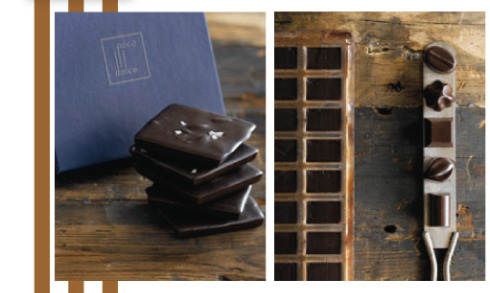
There is an empty canister of Poco Dolce Espresso Toffee chocolates sitting behind my desk at work. I’ve opened it every few days over the past couple of weeks hoping that it would miraculously be full again of chocolate. (You think I’m kidding – sadly I’m not.) I really should replace it before I go crazy for good.
I remember vividly the day that I had my first Poco Dolce chocolate square (they call them tiles). I had just completed a long walk, over two very big hills, and ended up at Chocolate Covered in Noe Valley – the fine purveyors of just about any chocolate you can think of eating. The interaction went something like this: Me: “JACK! I need a most delicious chocolate that I can eat immediately! I need something exciting! I need your best!” Jack: Knowingly hands me a Poco Dolce Aztec Dark Chocolate Tile flecked with Sea Salt.
Jumpin’ Jehoshaphat! – it was a like a multiple layer explosion.
Deep, dark chocolate. Spicy chile pepper with hints of cinnamon. Crunchy little toasted pumpkin seeds nestled in between. And flecks of salt that make the chocolate sing! You experience each individual layer and then they mix together and… I can’t come close to giving them justice, you really have to just try one.
And, the company is run by a smart and entrepreneurial woman, Kathy Wiley, here in San Francisco. I’ve been tempted to scream out “YOU GO GIRL” on the times that I’ve met her in the flesh, but that is embarrassing and a little ridiculous, and I really just think that aside from the fantastic chocolate, it’s just really inspiring to see women as leaders in the food industry.
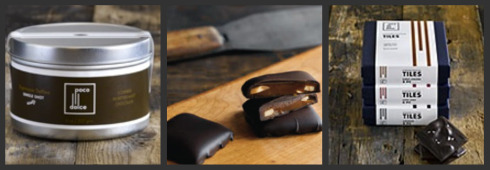
Poco Dolce chocolate is a perfect stocking stuffer. Poco Dolce chocolate is a perfect afternoon snack, perfect breakfast, perfect gift for someone you really care about, perfect stress reducer, you name it. Poco Dolce chocolate is really just perfect. Do yourself a favor and buy some of these. You can thank me later. (Preferably with a shipment of Tile Trio).
Prices run from about $2.50 a square to $16 for an 8 oz canister of toffee squares, $18 for a box of 8 tiles, $22 for a sampler of toffee squares, to $50 for the Trifecta box of Tiles, sure to make you an instant hero to the special recipient. For chocolate of this quality and deliciousness a pretty good deal.
pocodolce.com
415.255.1443
info@pocodolce.com
Chocolate Covered
4069 24th St (between Castro St & Noe St)
San Francisco, CA 94114
(415) 641-8123


























